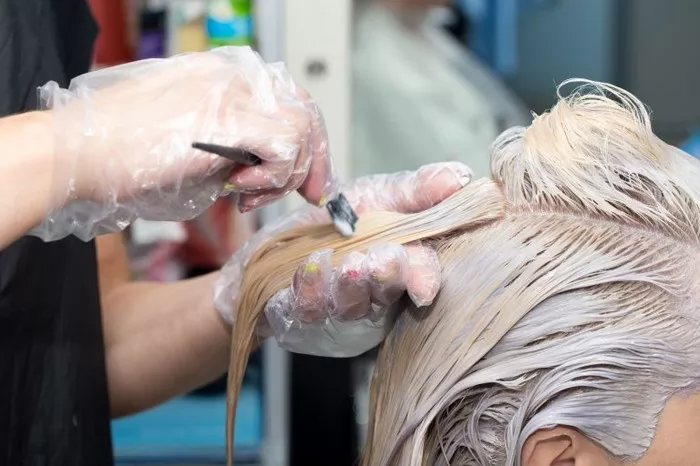Bleaching your hair is a transformative process that removes natural pigment, but it often leaves behind unwanted yellow, orange, or brassy tones. Toner is the secret weapon to neutralize these hues and achieve your desired shade, whether it’s icy platinum, soft beige, or cool ash. This guide will explain everything you need to know about choosing and using the right toner for bleached hair, including types of toners, color theory, application steps, and aftercare.
Why Do You Need Toner After Bleaching?
Bleaching works by lifting your hair’s natural pigment (melanin) through a chemical process. However, it doesn’t always leave hair evenly lightened. Depending on your starting color and bleach strength, hair can turn yellow (Level 8–9), orange (Level 6–7), or even red (Level 5). These warm tones clash with cool or neutral hair goals.
How Toner Works
Toners are semi-permanent or demi-permanent colors that deposit pigments to counteract unwanted warmth. They work like a filter, balancing undertones without drastically altering your base color. For example:
- Violet toner cancels yellow.
- Blue toner neutralizes orange.
- Green toner fixes red undertones.
Without toner, bleached hair often looks dull, uneven, or overly warm.
Types of Hair Toners
Toners come in different formulas, each suited to specific needs.
Liquid Toners
- What They Are: Ammonia-based, mixed with a developer (e.g., 10–20 volume).
- Best For: Strong, quick toning. Ideal for stubborn brassiness.
- Pros: Long-lasting (4–6 weeks), vibrant results.
- Cons: Can dry hair; requires precision.
Cream Toners
- What They Are: Gentler, conditioning formulas. Mixed with low-volume developers (5–10 volume).
- Best For: Dry or damaged hair. Subtle toning.
- Pros: Moisturizing, even application.
- Cons: Less intense; fades faster (2–4 weeks).
Purple or Blue Shampoos
- What They Are: Temporary toning shampoos with violet/blue pigments.
- Best For: Maintaining color between salon visits.
- Pros: Easy to use, no developer needed.
- Cons: Weak for severe brassiness; overuse can cause purple/gray tints.
Demi-Permanent Toners
- What They Are: Deposit-only color (no ammonia) mixed with low-volume developer.
- Best For: Refreshing color without commitment.
- Pros: Gentle, shiny finish.
- Cons: Lasts 2–3 weeks.
Choosing the Right Toner: Color Theory Basics
Determine Your Hair’s Undertone
- Yellow: Pale, banana-like hue (common in Level 9–10 hair).
- Orange: Pumpkin or copper tones (Level 7–8).
- Red: Rusty undertones (common in dark hair bleached to Level 5–6).
Match Toner to Your Goal
- Platinum/Silver: Use violet toner on pale yellow hair.
- Beige/Champagne: Mix violet + blue for golden-blonde hair.
- Ash Brown: Green-based toner for dark, reddish bleached hair.
Check Hair Condition
- Damaged Hair: Avoid liquid toners with high-volume developer. Opt for cream or demi-permanent formulas.
- Healthy Hair: Liquid toners provide longer-lasting results.
How to Apply Toner: Step-by-Step
Prep Work
Bleach First: Lighten hair to the correct level (e.g., Level 9 for platinum).
Shampoo: Use clarifying shampoo to remove bleach residue.
Dry Hair: Towel-dry until damp (toner adheres better to damp hair).
Mixing the Toner
Ratio: Follow instructions (usually 1:2 toner to developer).
Developer Strength:
- 10 Volume: Subtle toning, minimal damage.
- 20 Volume: Stronger pigment deposit (use sparingly).
Application
- Section Hair: Clip into four parts.
- Apply Quickly: Use a brush, starting at the roots (darker) to ends.
- Process Time: 10–30 minutes (check every 5 minutes).
- Rinse: Cool water until clear. Follow with conditioner.
Aftercare: Keeping Your Toned Hair Fresh
- Use Sulfate-Free Shampoo: Preserves color.
- Cold Water Rinses: Seal cuticles, lock in pigment.
- Purple Shampoo: Use 1–2x weekly to maintain brightness.
- Avoid Heat Tools: High heat fades toner faster.
- Deep Condition: Repair bleach damage (olive oil or protein masks).
Common Mistakes to Avoid
- Wrong Toner Shade: Using violet on orange hair = murky results.
- Over-Toning: Leaves hair gray or purple.
- Skipping Strand Test: Always test a section first!
- Ignoring Developer Strength: High volume = more damage.
Conclusion
Choosing the right toner depends on your hair’s undertone, condition, and desired result. Always prioritize hair health, and don’t hesitate to consult a professional for tricky cases. With the right toner and care, you can turn brassy, bleached hair into a cool, salon-worthy masterpiece.
Related topics:
What Does Hair Toner Do to Bleached Hair?
What Does Toner Do to Bleached Hair?
What Toner Should I Use for Bleached Hair


